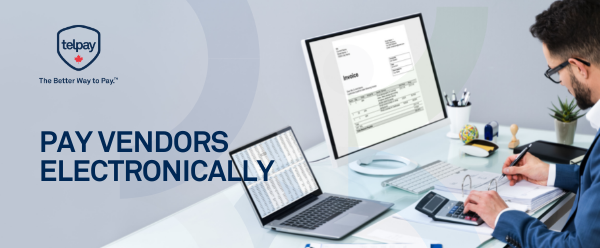
It’s no secret that the usage of cheques has been on the decline for several years and the increase of electronic payments options has been steadily on the rise. It is especially apparent when you feel the sting of what it now costs to order cheques when your supplier doesn’t want to accept another form of payment.
But why are some vendors and suppliers adverse to accepting electronic payments when there are so many benefits?
- They are paid more quickly and securely.
- It’s easy. The funds are directly deposited into their accounts. No-muss. No-fuss.
- Electronic payments come with details as to what the payment is for.
- No depositing or misplacing of cheques to be worried about.
- They are FREE.
All great reasons to make the switch, right? Well, let’s take a look at some of the most common reasons why vendors and suppliers are reluctant to make the switch:
- They Think It Will Take Too Much Time
Like many people, when they have a system that works for them, the idea of having to switch to something new feels like a huge uphill climb. Without knowing the benefits or how it works, they may think that they will have to learn, or worse yet, train others on how to use some new kind of system and if what they have isn’t broken, why fix it?
- They Don’t Like Change
“The system I have now works just fine.” A common response when trying to implement something new to someone who rejects change. If they haven’t received electronic payments before, how do they know that it isn’t better? It’s not a fair comparison if receiving cheques is all they have ever done. Showing them how B2B electronic payments are going to make life easier for them may open up a whole new way of thinking.
- They Think Electronic Payments Are Less Secure
People hear about fraud and scams that happen in “cyber-space” and because that’s a really big, unknown place, people who prefer to deal with tangible currency tend to think that their money is apt to disappear into the twisting nether. Of course, we know that’s not the case. What they don’t understand is that paper cheques are the most vulnerable form of payment when it comes to security, while on the other hand, electronic payments are traceable and have some of the highest security standards around.
Explaining The Benefits to Your Suppliers and Vendors
Let them know what the benefits of receiving electronic payments are:
- Knowing exactly when their payments are going to arrive. No more having to wait on the Postman to deliver their mail or worry about the cheque getting lost in the mail.
- Knowing exactly what the payment is for. Talk about a time saver! No more having to look up who the cheque is from and what the payment is in regards to. With electronic payments, they will also receive a reconciliation report that gives them all the information they need about the payment.
- Knowing their AR department will run more efficiently. Paper cheques require the processor to be in the same physical space as the cheques themselves, whereas electronic payments can be received from anywhere with an internet connection and the click of a button.
To get started, download the Supplier Direct Deposit Form found near the bottom of our Tips and Best Practices for Notifying Your Suppliers page and ask your suppliers to have the completed document returned to you.
It is very important that all information provided in the document is accurate and confirmed.
We recommend contacting your supplier, once you receive the completed form, to confirm the information.
Usually, people are more likely to try something new if you give them an out, should they change their mind. Let your skeptical vendors and suppliers know that if they try electronic payments for a month or two and still prefer to go back to cheques, they can do that. I’m confident that once they see how easy Telpay makes it and how beneficial it is, they won’t want to go back.
